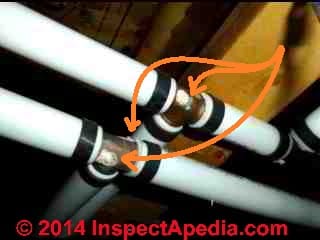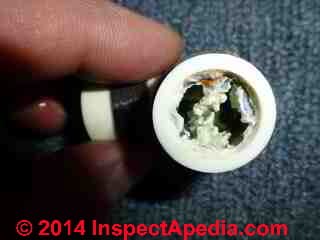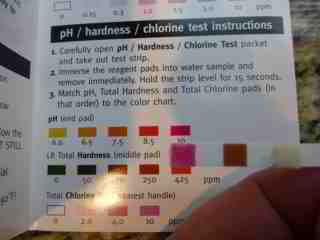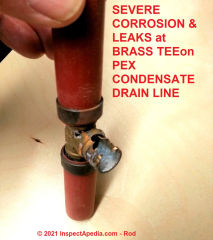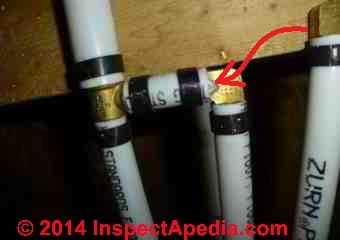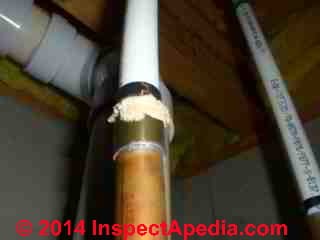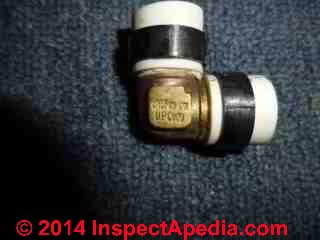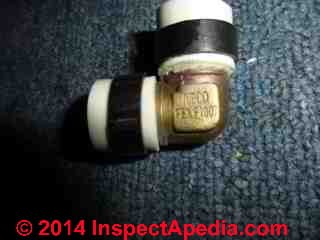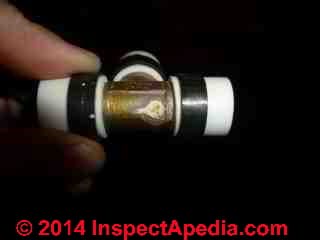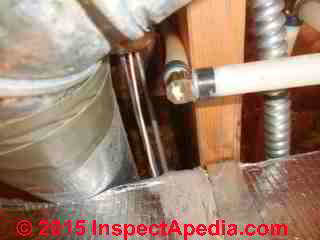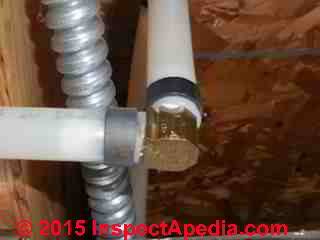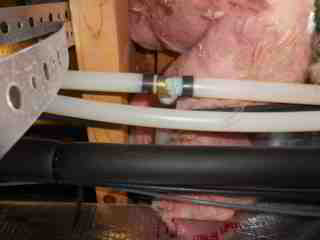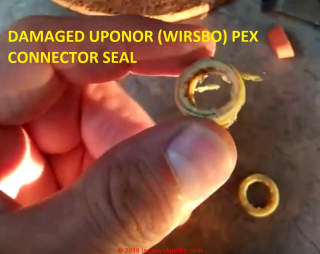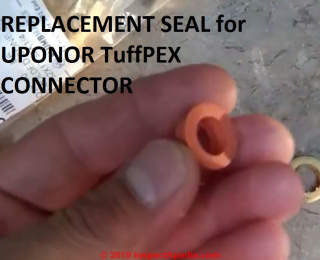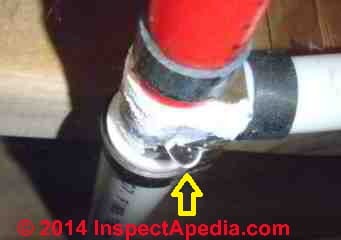 Brass Connector Corrosion, Leaks, Dezincification in PEX Piping Systems
Brass Connector Corrosion, Leaks, Dezincification in PEX Piping Systems
Current corrosion, links, meringue dezincification reports for PEX connectors in Ohio & Michigan
- POST a QUESTION or COMMENT about PEX polyethylene plastic supply piping brass fitting failures, corrosion, leaks, dezincification
PEX Piping Brass Fitting Corrosion, Leaks, & dezincification failures:
Current field reports & photographs of corrosion, leaks, & obstructive corrosion build-up inside of brass elbows, tees, & adapters used with plastic PEX water supply piping.
This article reports on current observations of corrosion & leakage in PEX piping systems in recently-constructed homes in the U.S., particularly in Ohio & Michigan.
We also include a field report of leaks at PEX connectors due to damaged PEX connector seal inserts in fittings used to connect the tubing to other metal plumbing fittings such as a shower control.
InspectAPedia tolerates no conflicts of interest. We have no relationship with advertisers, products, or services discussed at this website.
- Daniel Friedman, Publisher/Editor/Author - See WHO ARE WE?
PEX Dezincification Update & Research: field failure photographs of Brass PEX Pipe Fitting Corrosion & Leaks
This article series discusses the properties of Pex Tubing or Piping, Cross-Linked Polyethylene (PEX).
We address pex tubing & fitting failures and leaks reported for some U.S. states: field photographs & reports of brass connector leaks, corrosion, blockages possibly ascribed to dezincification of brass connectors used with PEX plumbing systems. Symptoms include visible corrosion, water leakage, & possibly obstructed water supply piping resulting in reduced water flow at fixtures.
Updates on Pex fitting de-zincification problems reported from the field. Pex dezincification research citations.
We discuss the uses of PEX tubing for water supply & in heating applications and we describe several different types of PEX tubing connector systems used including PEX crimp fittings, PEX compression fittings, PEX expander fittings, PEX Press-Fit connectors, and PEX Shark-Bite fittings and connectors.
[Click to enlarge any image]
Article Contents
- PEX BRASS CONNECTOR LEAKS
- DEFINITION of DEZINCIFICATION, BRASS, GUNMETAL
- DEZINCIFICATION CAUSES
- DE-ZINCIFICATION vs WATER SUPPLY PROPENSITY
- DEZINCIFICATION vs WATER SUPPLY pH
- DEZINCIFICATION WATER TESTS
- DEZINCIFICATION FIELD REPORTS
- LEAD LEACHING WARNINGS
- DZR DEZINCIFICATION-RESISTANT FITTINGS
- RESEARCH on DEZINCIFICATION
- PEX CONNECTOR LEAKS FROM SEAL DAMAGE at Wirsbo / Uponor PEX fitrtings
Above left: perforation corrosion visible on two brass Tee-connectors installed on PEX water supply piping observed in a midwestern U.S. home constructed in 2009 (orange arrows). Above right, brass tee corrosion appearing both on the Tee-fitting body (red arrow) and around the end of the PEX tubing (green arrow) on water piping in a 2009 home. [Click to enlarge any image]
Definition of Brass, Gunmetal, Dezincification, & Meringue Dezincification
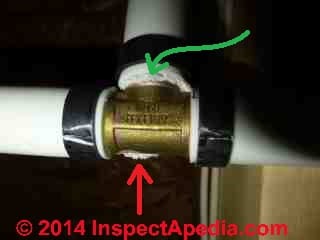 Brass is a generic term used to describe a family of alloys made principally from copper and zinc where zinc is alloyed with copper in percentages ranging from 15% to 40%.
Brass is a generic term used to describe a family of alloys made principally from copper and zinc where zinc is alloyed with copper in percentages ranging from 15% to 40%.
Some "brass" fittings sold worldwide, including plumbing fittings, may also contain lead, tin, and zinc and would more properly be called "gunmetals".
Gunmetal alloys are used only in the manufacture of cast items.
The U.K.'s Foundation for Water Research explains that the function of lead in castings is to reduce the porosity of the final product: as lead is the last ingredient to solidify when casting a part, the lead can be drawn into openings or pores in the product to reduce the chance that it has a pinhole leak.
What this means to a builder, home owner, inspector or investigator of plumbing systems and water supply piping is that the observation of cast brass plumbing fittings (as opposed to machined fittings) means that the fittings may contain lead that particularly in the presence of low pH water (acidic water) may leach into the water supply. We discuss this concern
at LEAD LEACHING WARNINGS.
Dezincification (shown below) refers to the loss of zinc from a brass plumbing fitting by dissolution, ultimately leading to leaks or broken fittings.
Zinc present in the brass alloy dissolves leaving pores or openings that can become water leaks. Dezincification also weakens the remaining fitting, increasing the risk that the fitting or other brass parts such as the stem of a water control valve might break.
Meringue dezincification (shown below) is a special case of corrosion of brass plumbing fittings that occurs in high pH water (above 8.2 or basic water), leaving corroded material as a white deposit (probably salts) that clogs brass fittings and reduces water flow rates.
Meringue dezincification might explain some reader reports we receive of a decrease in hot water flow rate at some plumbing fixtures, particularly those used most-often and at highest-temperatures.
Since both clogging (meringue dezincification) and perforation leaks may occur at the same time on water supply systems, another step in identifying the type of dezincification occurring might be to test the water pH level.
See DE-ZINCIFICATION vs WATER CHEMISTRY
Definition & Causes of "Dezincification" & "Meringue Dezincification" of Brass Plumbing Fittings
The process of dezincification of brass water piping system components includes at least the following contributors
- Water chemistry - Water pH: water of chemistries that are that high in pH (basic) or low in pH (acidic) and even water that is neutral in pH all ultimately are expected to corrode brass plumbing fittings. However just how the corrosion is manifested (leaks, blockages, breakage failures) varies by water chemistry and time.
- Water chemistry - level of Chlorine: water that is high in chlorine is likely to experience faster dezincification.
Chlorine is added to both public and private water supplies but in our OPINION is likely to be less carefully controlled to be kept within recommended levels in private water supply systems. - Water temperature plays a role in dezincification too .
Though dezincification occurs in both hot and cold water piping, the dissolution of zinc from brass fittings by dezincification is more rapid in hot water piping and systems than in cold water piping. Combining hot water, high chlorine and low pH with brass fittings increases the risk of dezincification and leaks in the plumbing system. - Alloy composition of the brass fitting:The percentage of zinc in brass varies according to the manufacturing process and most likely the intended use of the product.
A brass fitting using a lower percentage of zinc is likely to suffer dezincification at a lower rate than a high-zinc fitting. A "pure brass" fitting containing only zinc may be less prone to perforation that an alloy that includes lead. - Manufacturing process of the brass fitting: gunmetal components intended for manufacture by casting are likely to contain lead and thus may pose a risk of lead leaching into the water supply.
Brass that does not include lead and that is fabricated into final product form by machining is still vulnerable to dezincification depending on water chemistry and temperature.
Experts such as the Foundation for Water Research in the U.K. point out that while both brass and gunmetal alloys are vulnerable to corrosion and dezincification, brass alloys are more vulnerable to dezincification than gunmetals.
Dezincification Propensity of the Water Supply Chemistry
Zhang (2009) ranked water supplies in different areas of the United States according to the propensity of the water supply to encourage leaching of zinc, copper, and lead leaching over a 100-day test period. He ranked the following water supplies from highest to lowest.
[Table construction & excerpting shown below are adapted from the author's original text - Ed.]
Effects of Water Chemistry on Leaching of Metals from Metal Components: Copper or Brass Piping & Fittings |
|
Propensity for Dezincification [1][4] |
Selective Leaching of Zinc vs Copper [2] |
| Rhode Island | Santa Clarita |
| San Diego | San Diego |
| Santa Clarita | Chapel Hill |
| Las Vegas | Las Vegas |
| Chapel Hill | Seattle |
| Seattle | Blacksburg |
| Blacksburg | Rhode Island [3] |
Notes to the table above
Original source: Zhang, Yaofu. "Dezincification and brass lead leaching in premise plumbing systems: effects of alloy, physical conditions and water chemistry." PhD diss., Virginia Polytechnic Institute and State University, 2009. - http://scholar.lib.vt.edu/theses/available/etd-12182009-203827/unrestricted/Zhang_Y_T_2009.pdf
[1] Zinc leaches into the water supply; 100-day test; note that this same effect can cause corrosion and leaks as are illustrated and reported in this article.
[2] Focused on the last 1200 hours as indicative of a longer-term trend the table order is revised as shown in this column
[3] Zhang noted that Rhode Island water has a low pH, allowing copper to dissolve together with zinc. The author points out a consideration important for inspectors testing the water supply: don't just test for high chlorine. A low pH water supply may cause brass fittings to fail by general corrosion rather than dezincification.
[4] Interestingly the author found that either a focus on the last test period (when corrosion was most advanced and presumably the rate of corrosion was accelerating) or on the total weight loss of the metal components (how much material has been lost) gave the same ranking after loose scale material was removed to leave just the brass intact.
Water Chemistry: Effects pH on Brass Fittings
Effects of Low pH Water on Brass Fittings: Corrosion
Zhang (2009) observed that water that is low in pH (such as in Rhode Island in the U.S.) is likely to cause brass fittings to fail by general corrosion rather than meringue dezincification. That's because low pH allows both copper and zinc to dissolve together. Water with a low pH means that the water is "acidic" to use a term familiar to many people.
The significance of Zhang's observation is that we might find PEX brass fittings or other brass piping or fittings failing and leaking "prematurely" on water supplies that are of low pH regardless of the chlorine level, or exacerbated if the water supply is low in pH and chlorine is being added at high levels.
Effects of High pH Water on Brass Fittings: precipitation & clogging - Meringue Dezincification
The Foundation for Water Research (FWR) points out that high pH water (water that is basic or has a pH above 8.2) causes corroded ingredients of a brass fitting to precipitate out of the water supply and to settle in the fitting itself. This effect leads to clogging: reduced water flow through the system, and is referred to throughout contemporary brass fitting failure literature as "meringue dezincification".
Effects of Neutral pH Water on Water Piping Systems
Neutral pH water is water with a pH in the range of 7.6 to 8.2. When the water supply is maintained within this neutral pH range brass fittings and other brass components in water supply systems (such as control or stop valve stems & gate valve components) will still experience corrosion, but at a slower rate. The FWR report we cite
at RESEARCH on DEZINCIFICATION
states that in this neutral pH range there will be no build up of a corroded material deposit (no meringue dezincification) and that "... it takes in the region of 15 years for the walls of the fittings to become penetrated.
The snapping of tap and valve spindles ... is another manifestation of the problem." - Foundation for Water Research (2003).
See WELL DISINFECTANT pH ADJUSTMENT
The FWR concludes (for U.K. Readers - as recommendations in other countries may vary) that plumbers should use only dezincification-immune (gunmetal) or dezincification-resistant (marked DR in the U.K.) brasses on water supply systems that initiate or propagate dezincification corrosion.
Watch out: since gunmetal fittings may contain lead there could still be a lead leach-out and water contamination concern. In the E.U., a 2013 EC directive restricts the allowable level of lead in drinking water to 15 mcg/L (micrograms per litre).
In the U.K. and the rest of the E.C., see
- European Council Directive 98/93/EC, 3 November 1998, Quality of Water Intended for Human Consumption
- EN 15664-1:2008, Influence of metallic materials on water intended for human consumption. Dynamic rig test for assessment of metal release. Design and operation.
- EN 15664-2: 2010, Influence of metallic materials on water intended for human consumption, part 2.
Simple Inexpensive Methods of Testing the Water Supply for Chlorine & pH
For investigators of dezincification who are including water testing in their inspection procedure, we suggest that In addition to testing for the chlorine level, investigators should test the water pH.
Testing the pH of a water supply is as easy as testing its chlorine level as simple litmus paper strips will suffice to make a general test of the pH of a water supply.
While our correspondent, an inspector discussing dezincification, described using pH testing in the field, he warned that most field inspectos are not attempting the same level of testing as might be performed by a more-expert water testing laboratory.
However simple pH testing by litmus paper or by instrument is widely used by water test services as well as those building inspectors who perform basic investigation services. And if conducted properly (for example using fresh, uncontaminated litmus paper tests), measuring water pH using litmus paper strips is an accurate approach.
Both litmus paper and pH meters can be used to perform this test and have been in wide use for a over 100 years since Sorensen (1909) first proposed this test. Contemporary pH meters and litmus paper are in fact similarly accurate. Kahn points out that
The significance of changes in pH level, for instance, differ slightly depending on whether pH is measured by litmus paper or the more accurate pH meter. - Kahn (1985)
while Thomas (discussing measurement of soil acidity) points out that
As recently as two decades ago, the use of the small, handheld portable pH meters then available to determine pH in the field was a very imprecise and hazardous undertaking because both electrodes and meters were subject to sudden failures but this has changed rather abruptly in the last few years. Microcircuitry and plastic have contributed to rugged pH meters and electrodes that witstand ... - Thoms (1996)
Watch out: What about pH variations over time? A single pH test of a water supply can be taken only as a reasonable estimate of the water's chemistry at the time the test was taken. While the pH of most water supply systems is probably rather consistent over time, environmental, weather, or other variables might cause pH values to vary in private water supply systems and possibly even in municipal water supplies.
In addition to the RESEARCH on DEZINCIFICATION in this article, also see the water pH testing research found at this article'sReferences or Citations section.
If you decide to make some tests including pH I hope you'll report the results to us.
See CHLORINE TESTS, WATER for an explanation of methods to test the chlorine level in water
and/or
See WATER DISINFECTANT QUANTITY.
See WELL DISINFECTANT pH ADJUSTMENT for a discussion of the relationship between chlorine and water pH.
Reader Reports PEX piping brass fitting dezincification in Ohio & Michigan, U.S.
Comment: severe corrosion & leak at brass TEE on PEX condensate drain piping
My 10 year old (+or -) gas furnace has a condensate pump. The installer used a 3/4" pex w/ brass fitting between the furnace and pump, which I recently discovered was completely eaten through. The immediate fix is replacing the fitting with a plastic one, but who knows what this has done to my cast iron drain pipe!
I think condensate neutralizers should be required by code (if they're not) and installed as a matter of course. They're a lot cheaper than fixing leaking pipes.
This discussion was posted originally at
Moderator reply:
Thank you for the helpful field failure report of severe corrosion at a brass PEX connecting tee handling gas furnace condensate;
I'll be sure to keep your photo and report with that topic whose link I'll give here;
Can you see if there is a brand or identification mark of any kind on that correded brass Tee?
I ask because you'll see there was a well-known brass connector corrosion, leak failure problem a while back - see details
at
See PEX BRASS CONNECTOR LEAKS - field reports of de-zincification corrosion and leaks at brass PEX pipe connectors, elbows & tees.
at
inspectapedia.com/plumbing/PEX_Brass_Fitting_Leaks_De_Zincification.php
I'll copy this conversation over to that page to invite comment from others who have seen this problem.
And I agree that corrosivity of condensate from a condensing gas furnace is a concern - as has beeen noted in research going back at least half a century. Some examples are below.
- Boulton, L. H. CORROSION OF BUILDING ASSETS–PROBLEMS AND PREVENTION [PDF Les Boulton & Associates Ltd. Auckland, New Zealand, at Australian website corrosion.com.au, retrieved 2021/04/04
- Brodrick, James R., and Alex Moore. CONQUERING CORROSION [in gas furnaces and vent systems], [PDF] ASHRAE Journal 42, no. 4 (2000): 29.
Introduction:
During the 20th century, concerns about corrosion in the components of furnaces and vent systems limited the upper efficiency level for safe practice. The initial entry into the condensing regime resulted in many setbacks and financially ruined businesses.
More than 50 years after the onset of corrosion problems, a remedy was found. Materials research played a key role in reducing the corrosion problem. Market forces, such as fuel price variations, first reduced and then accelerated the R&D that was needed to overcome the corrosion problem. A
brief, selected history is provided on the key players, dates, and events of this R&D quest. But, have the R&D costs and ensuing benefits paid off for the U.S. consumer? - DeWerth, D. W., and A. M. Waters. "Corrosive effects of condensate." (1981).
- Hindin, Barry, and Arun K. Agrawal. "Materials Performance for Residential High Efficiency Condensing Furnaces." In The Use of Synthetic Environments for Corrosion Testing. ASTM International, 1988.
Abstract
In high efficiency furnaces, the condensate that is produced from the flue gas contains trace amounts of such contaminants as SOx=, Cl− (chloride ions), NO3− (nitrate ion), NO2− (nitrate ion), F− (fluoride ions), and organic acids. The condensate after concentration by reevaporation becomes very corrosive to the heat exchanger materials. An electrochemical investigation has been conducted using 316L as a reference alloy and synthetic condensates to identify the environmental factors most significant in corrosion.
The condensates were formulated using a statistical experimental design approach. Through a regression analysis of the results, chloride and temperature were identified as the most damaging factors. Investigation of several other alloys in an aggressive condensate showed that their corrosion performance was dependent upon their Cr and Mo contents. Subsequently, a large number of alloys were evaluated in a gas-fired furnace by exposing them to chloride-spiked condensates under alternate wetting and drying conditions for 90 days.
The alloys included austenitic, ferritic, and duplex stainless steels, and also a few aluminum, copper, and nickel-based alloys. Most of the alloys performed well in the condensate having 26 ppm Cl−; a few of the alloys did well in 200 ppm Cl−, but at 1000 ppm Cl− only those alloys which had high Cr and Mo contents survived. - Huijbregts, W. M. M., and R. G. I. Leferink. "Latest advances in the understanding of acid dewpoint corrosion: corrosion and stress corrosion cracking in combustion gas condensates." Anti-Corrosion Methods and Materials (2004).
Abstract:
Corrosion failures due to condensing flue gases containing H2O, SO3, NOx and HCl still occur more often than might be expected. The corrosion failures can be of several types: general corrosion, pitting attack and stress corrosion cracking (SCC). The chemistry of condensing gases is discussed, and some examples of corrosion in large‐scale installations are presented, including blast stoves for steel production, heat recovery steam generators, and waste incineration boilers.
The use of thermal insulation inside boiler casings can result in nitrate SCC when the flue gas contains high concentrations of NOx. Nitric acid from flue gas can react with carbon steel and insulation material forming ammonium nitrate and calcium nitrate. Both materials have hygroscopic properties and are very corrosive, even above the water dewpoint of the gases. - Miller, W. K., R. Shipley, R. Parrington, and D. Dennies. "Stress-corrosion cracking." (1993).
8/19/2014 Anonymous said:
We are experiencing quite a lot of PEX brass fitting dezincification in Ohio and Michigan, with increasing issues with PEX brass fitting corrosion anywhere from 1997 through 2013 construction.
Our water is supplied from Lake Erie and you may be well aware of the water issues we have experienced since about 2008 with green algae blooms and the efforts to treat the drinking water.
At above left we observe multiple perforation & corrosion deterioration of this brass PEX pipe tee and yellow / green stains that suggest that the corrosion has advanced to the point of active water leakage (yellow arrow). At above right we can observe water dripping from this still more severely-corroded brass PEX pipe tee (yellow arrow).
From minor almost nonexistent corrosion on the brass fitting exterior to active leakage from fitting failure due to leaching out of the zinc. Is there any information compilation you are preparing for the public to educate themselves on related to zinc fitting issues from the late 1990's to 2013?
There is no one manufacturer whose fittings we see issues with. We do not see Kitec™ issues as there has been very limited usage in the region. We have seen Zurn - Qest™ and Nibco™ as the primary brands of leaky brass fittings in this application.
Thank you. Note I have photos etc. if interested in continuing this discussion. [Photographs of de-zincification in PEX piping connectors & fittings are reprinted herein with permission of contributors who requested anonymity, 12 Sept 2014 - Ed.]
At above left we see white corrosion creeping along the side of a brass elbow that was used to connect segments of Zurn® PEX white piping in a home constructed in 2004.
Below is an example of brass coupling corrosion connecting copper piping to PEX piping in a midwestern state home constructed in 2003.
[Click to enlarge any image]
Reply:
It's worrisome that dezincification of PEX fittings continues as an ongoing issue.
Please use my email found at our CONTACT link to send me whatever photos, reports, documents you can for publishing here both to inform other readers and to solicit additional field reports, research & advice regarding contemporary or ongoing PEX pipe connector & fitting corrosion, leaks or failures.
Above & below are identification photographs of a NIBCO brass PEX elbow removed from a domestic water heater piping installation.
The readers made clear that the dezincification / brass PEX fitting corrosion and leak problems they are observing in Midwestern U.S. states do not appear to be confined to a single manufacturer or brand.
At below left the contributors illustrate perforation corrosion of a brass PEX Tee fitting.
Below you can observe the considerable deposit of minerals / corrosion material built-up inside the body of this brass PEX Tee fitting.
This particular form of dezincification is identified as meringue dezincification and produces clogging and reduced water flow rates.
Even before building occupants observe the effects of corroded leaky PEX brass pipe fittings they may report a symptom of reduced water flow rate and they may notice that effect first at the hot water side of plumbing fixtures.
Also see CLOGGED SUPPLY PIPES, DIAGNOSIS
PEX Fitting & Tubing Failures, Class Action Litigation Information
The PEX brass fitting manufacturing companies mentioned in the readers' observations include
- Qitec, Inc., perhaps misnamed by the writer: see Kitec® (IPEC) discussed beginning at PEX PIPING INFORMATION. IPEX recalled Kitec®, or Kyetec brand of brass plumbing fittings in 2005.
Also see Kitek® PLASTIC PIPELEAKS & LAWSUIT - separate article that discusses this class action settlement from which we excerpt:
The Settlement creates a one hundred and twenty five million U.S. dollar (US$125,000,000) Settlement Fund (less attorneys’ fees and costs set forth below) to be used for the benefit of the Class to pay for the repair of buildings, residences, homes or other structures plumbed with the Kitec System. Any money paid from the Settlement Fund to members of the Settlement Classes will be paid in the class member’s local currency.
The Plan Of Allocation describes the amounts and conditions of the benefits to the Class. NOTE: To be eligible to receive any money from the Settlement Fund, you must complete and submit the Claim Form accompanying the Notice available on the Case Documents page. The claim filing deadline is January 9, 2020.
After the Claims Deadline, any funds remaining in the Settlement Fund after all payments to those Class Members filing proper Claim Forms, will be returned to the IPEX Funding Entities. Claims made after the Claims Deadline will be rejected. - retrieved 9/11/14, original source http://www.kitecsettlement.com/faq.cfm - NIBCO INC.
1516 Middlebury Street
P.O. Box 1167
Elkhart, IN 46515-1167, Website: http://www.nibco.com/
Quoting from the company's product description:
The NIBCO® PEX system offers a variety of fittings to suit various types of installations. Choose from metal fittings, poly fittings, or poly Push ‘N Go® fittings featuring the push connection method. NIBCO® PEX fittings, tubing, valves, and manifolds are designed to be used as a complete system.
Phone / Fax – U.S.:
Customer Service Phone (Toll-Free): 800.234.0227
Customer Service Fax (Toll-Free): 800.234.0557
Tech Services (Toll-Free): 888.446.4226
Tech Services Fax (Toll-Free): 888.336.4226
Phone / Fax – International:
International Phone: +1/574.295.3221
International Fax: +1/574.295.3455
Email:
Customer Service: CustomerService@nibco.com
Technical Services: CS-TechnicalServices@nibco.com
Public Relations: pr@nibco.com
International Customer Service: International@nibco.com
More Reader Reports of Pex brass fitting dezincification:
(Aug 19, 2014 & atain 12 March 2015) an anonymous home inspector
said:
We are experiencing quite a lot of PEX brass fitting dezincification in the NW OH, SE MI region. From minor almost nonexistent corrosion on the brass fitting exterior to active leakage from fitting failure due to leaching out of the zinc.
Is there any information compilation you are preparing for the public to educate themselves on related to zinc fitting issues from the late 1990's to 2013? There is no one manufacturer whose fittings we see issues with. Nibco and Qitec are the top two that seem to be used in our market.
Thank you. Note I have photos etc. if interested in continuing this discussion.
12 March 2015 Anonymous wrote:
Dan, I have a few additional photos of PEX fittings showing an interesting perspective. When you receive them, note the build up of the "meringue" corrosion inside the tubing that extends from the fitting.
The home was constructed in 1995 widening our area of concern to earlier than 1997 as we had previously identified through research and inspection findings. The PH levels in the regional public water supply have been found to be in elevated levels. We might blame some of this on the recent algal bloom issues we have been dealing with in the Lake Erie western basin.
Reply:
Anon: A search of InspectApedia for "Dezincification" will find this and other related articles on the topic.
It's worrisome to hear that even in 2015 dezincification of brass fittings used with PEX piping is a continuing issue. But the research in this field relating dezincification to water chemistry is both diagnostic and prescriptive.
Meanwhile in the article above I've added your 2015 merengue dezincification photos to your earlier report and some updated research citations on PEX and dezincification problems
We thus invite further comment from others.
Warnings About Lead & Copper Leaching into the Water Supply from Brass Piping, Fittings, Faucets - Water Chemistry Role
Watch out: some of the water conditions, particularly high levels of chlorine, that appear to play an important role in meringue dezincification of brass fittings on PEX piping systems may result in unsafe levels of lead as well as high levels of copper in the building water supply. Research by Kimborough (2007), Kumar (2007) and Zhang (2009) as well as other researchers warns that water chemistry combined with the properties of brass, copper, and lead and zinc-containing alloys can lead to trouble.
The following is excerpted from Zhang (2009):
Lead and zinc leaching from a range of brasses were negatively correlated. The mechanism behind this observation is not clear yet and needs future studies. But as a result DZR and red brasses release more lead to water, and a greater percentage of lead in the alloy to water.
Lead leaching is also found to be greatly influenced by water compositions. Higher chloride and lower alkalinity increase lead leaching. Orthophosphate at 1.4 mg/L decreases lead leaching, but the inhibitive effects are very sensitive to phosphate dosages.
Initially, dosing 40 mg/L of silicate also inhibited lead leaching, but the inhibitive effect of silicate diminished after 100 days of experiment. Adding 200 ppb of zinc slightly increased the lead concentrations in the water. Zinc does not seem to play a significant role in mitigating either dezincification or lead leaching from brass alloys.
When different water and the same alloy are considered, lead leaching was found to increase with higher zinc leaching. This result may help explain why some lead leaching cases were related with dezincification in practice.
Overall, there is a complex interplay between water chemistry and metallurgical composition that determines lead leaching to water. - Zhang, Yaofu. "Dezincification and brass lead leaching in premise plumbing systems: effects of alloy, physical conditions and water chemistry." PhD diss., Virginia Polytechnic Institute and State University, 2009.
See LEAD IN DRINKING WATER, HOW to REDUCE
DZR Brass: Dezincification-Resistant Plumbing Fittings
DZR or dezincification resistant fittings should be used to avoid future leaks and supply piping clogs due to dezincification, and are likely to be specified as the repair where water chemistry has already lead to brass fitting leaks or clogs.
Some companies already DZR-Brass fittings or alternatives including
- Nibco - http://www.nibco.com/fittings/metal-fittings/pressure-fittings/lead-free-cast-dzr-brass-fittings/
- Sioux Chief - http://www.siouxchief.com/no-lead/no-lead-product-markings
- Uponor's WIPEX fittings - DZR brass: http://www.uponor-usa.com/~/media/Uponor/Sidebar%20Brochures/LFBrsFitt_ProdG_1-10.ashx
- Incledon (note the location) - http://www.incledon.co.za/catalogues/14%20Valves%20General%20Purpose/3%20Cobra%20DZR_BRASS.pdf
Watch out: Danish researchers Andersen et als. found water damage due to corrosion even where DZR brass was used. The problems occur where the water supply has high conductivity - or as their paper cites, high alkalinity. Quoting:
In Danish drinking water installations, brass has been the most commonly used material for fittings such as stop valves and control valves; dezincification resistant (DZR) brass of the type CuZn36Pb2As being the dominating alloy.
DZR brass has traditionally been considered sufficiently corrosion-resistant to be used in all Danish water types, and previous experience has been good. However, today, an increasing number of severe water damage caused by corrosion of DZR brass in areas with hard, high conductivity ground water has increased the focus on corrosion of copper alloys and, as a consequence, recommendations have changed.
In the Copenhagen
area and other areas with similar water quality, it is now recommended to use fittings
of gun metal or stainless steel (AISI 316 or better).
...
Examinations confirm that the traditional copper alloys have unacceptably short life
expectancy in the hard, high conductivity water types found in Denmark. A major
reason is believed to be that the preferred pipe material has changed from hot-dip
galvanised steel to stainless steel and plastic. - Anderson et. als (2015).
Research citations on PEX and dezincification problems
- Asbjørn Andersen, Frank Fontenay, Lisbeth Rischel Hilbert, "Corrosion of brass in drinking water with high alkalinity", FORCE Technology, Denmark, Paper no. 4809 EUROCORR 2011 Conference Stockholm September 4th-8th 2011, retrieved 12 March 2015, original source: www.forcetechnology.com
- A. Andersen, F. Fontenay, S. Klingaard, K. Nielsen, SBI anvisning 227, Korrosion i VVS Installationer, Statens Byggeforskningsinstitut, 2009.
- ASTM B 828-02 "Standard Practice for Making Joints by Soldering of Copper to Copper Alloy Tube and Fitting."
- M. Ebner, Kupfer-Zink-Legierungen, Korrosionsphänomene und Möglichheiten ihrer Verhinderung, Sanitär und Heizungstechnik 4/2011.
- F. Fontenay, A. Andersen, S. Klingaard, failure of new brass components in high conductivity drinking water due to intergranular corrosion and stress corrosion cracking, NKM15 2010.
- Foundation for Water Research, "Causes of Copper Corrosion in Plumbing Systems", (2003) Foundation for Water Research, Allen House, The Listons, Liston Road, Marlow, Bucks SL7 1FD, U.K., Tel: 44 (0) 1628 891589, Email: office@fwr.org.uk Website: www.fwr.org, retrieved 12 March 2015, - original source: http://www.fwr.org/copper.pdf
- "REVISION RECORD FOR THE STATE OF CALIFORNIA EMERGENCY SUPPLEMENT August 18, 2010 2007 Title 24, Part 5, California Plumbing Code." EMERGENCY (2010).
- Hilbert, L. R., H. J. Albrechtsen, and A. Andersen. "Effect of material and water quality on disinfection and risks of corrosion." In The Annual Congress of the European Federation of Corrosion Eurocorr. 2010.
- Kimbrough, D. E. "Brass corrosion as a source of lead and copper in traditional and all-plastic distribution systems." Journal of American Water Works Association 99, no. 8 (August 2007): 70-76.
- Kitek® PLASTIC PIPE LEAKS, CLASS ACTION SETTLEMENT
- Kumar, S., T. S. N. Sankara Narayanan, A. Manimaran, and M. S. Kumar. "Effect of Lead concent on the dezincification behaviour of leaded brass in neutral and acidified 3.5% NaCl solution." Materials Chemistry and Physics 106 (2007): 134-141
- Lawrence, Benjamin L. "Sulfur treatment for copper zinc alloys." U.S. Patent Application 13/302,374, filed November 22, 2011.
- 26 October 2018 NIBCO PEX Class Action Lawsuit [PDF] opened, petaining to owners or occupants of NIBCO PEX plumbed buildings betweeen 1 January 2005 and the date of the class action suit; (A closure date is not yet evident - Ed.)
NIBCO PEX Tubing: PEX tubing manufactured or sold by NIBCO in the United States using (or labeled by NIBCO as using) its 1006 formulation and used in residential or commercial structures, including NIBCO NEXT-Pure Tubing, NIBCO DURA-PEX
Tubing, and NIBCO. The Tubing was manufactured until 2012.
NIBCO PEX Fittings: ASTM F1807 yellow brass fittings manufactured or sold by NIBCO in the United States for use in PEX applications and used in residential or commercial structures. NIBCO stopped manufacturing this product in 2015, though the significant majority had been manufactured and sold by the end of 2012.
NIBCO PEX Tubing Clamps: Stainless steel clamps manufactured or sold by NIBCO in the United States for use in PEX applications and used in residential or commercial structures. NIBCO stopped manufacturing this product in 2015, though the significant majority had been manufactured and sold by the end of 2012.
More information: NIBCO PEX SETTLEMENT CLAIMS WEBSITE at https://www.pexsystemsettlement.com/ providing claims forms, contact information and other information for consumers.
KIMBERLY COLE, et al, on behalf of themselves and all others similarly situated, [PDF] Plaintiffs, vs. NIBCO, Inc., Defendant UNITED STATES DISTRICT COURT FOR THE DISTRICT OF NEW JERSEY Civil Action No. 13-cv-7871 (FLW)(TJB)]
Excerpt: If the Qualifying Leak occurred between January 1, 2005 and May 16th, 2019 (the Effective Date), the deadline for submitting a Claim Form is October 13, 2019 (150 days after the Effective Date). If the Qualifying Leak occurs during the Claim Period and after May 16th, 2019 (the Effective Date), the deadline for submitting a Claim Form is 150 days after the Qualifying Leak occurs.
If three (3) or more Qualifying Leaks are experienced, the deadline for submitting a re-plumb claim is October 13, 2019, (150 days after the Effective Date) if the leaks were experienced before May 16th, 2019 (the Effective Date) or 150 days after the third Qualifying Leak occurs if such third leak occurs after May 16th, 2019 (the Effective Date). The Claim Form is available on this website.
See also the NIBCO PEX CLASS ACTION SETTLEMENT NOTICE [PDF] at https://www.pexsystemsettlement.com/ Tel: 1-855-649-5968 Email: info@PexSystemSettlement.com.
See also PEX BRASS CONNECTOR LEAKS - web article
- Nielsen, K. "Metallic materials in Danish supply water systems." Water Science & Technology: Water Supply 1, no. 3 (2001): 83-90.
- Paige, J. I., and B. S. Covino. "Leachability of lead from selected copper-base alloys." Corrosion 48, no. 12 (December 1992): 1040-1046.
- Phillips, R. John. "In pursuit of the perfect pipe." Journal of Failure Analysis and Prevention 4, no. 1 (2004): 8-11.
- Russell, Larry L. "Dezincification of brass fittings–effects of metal solvency control measures." In Metals and Related Substances in Drinking Water: Proceedings of the 4th International Conference, Meteau, p. 216. IWA Publishing, 2012.
- Samuels, E. R., and J. C. Meranger. "Preliminary studies on the leaching of some trace metals from kitchen faucets." Water Research 18, no. 1 (Janurary 1984): 75-80
- Schock, M. R., and C. H. Neff. "Trace Metal Contamination From Brass Fittings."
Journal AWWA 80, no. 11 (November 1988): 47-56
- VERDEJO V. VANGUARD PIPING SYSTEMS, INC., Case No. BC448383, [PDF - Settlement Agreement] Action filed 28 October 2010 in the Superior Court of the State of California, County of Los Angeles before the Honorable William F. Highberger.
The parties have settled the Litigation and the settlement was approved and judgment entered. This class action arose out of the installation of allegedly defective high-zinc-content “yellow brass” plumbing fittings in residences.
KEY DATES in the Verdejo v Vanguard settlement agreement :
Deadline for filing claims arising from damages occurring on or after 10 July 2014: Within 180 days from date of accrual
Deadline for filing claims regarding useful life: 10 July 2015
Deadline for filing claims arising from damages occurring before 10 July 2014: 6 January 2015
NOTICE OF PENDENCY AND PROPOSED SETTLEMENT OF CLASS ACTION Relating to Vanguard and Viega-brand brass plumbing components [PDF]
Verdejo v. Vanguard Piping Systems, Inc. [PDF, Final Judgment], 17 September 2014
This website, hosted by a class action litigation law firm https://eclaim.kccllc.net/caclaimforms/vpv/home.aspx details how the settlement may affect your legal rights and your options if you are a Class Member.
Excerpt:
Plaintiffs allege they have suffered injuries and damages arising out of alleged defects in certain brass potable water plumbing system fittings or other components and sub-components used in potable water plumbing systems made from UNS C36000, UNS C37700, UNS C36500 brass, or similar copper alloys with a zinc content of 15+% designed, manufactured, and/or distributed by Vanguard Piping Systems, Inc., VG Pipe LLC, Viega LLC, or any and all of their current or former related subsidiaries, parent companies, sister companies, and affiliates ("Viega Brass Fittings").
The fittings include Vanguard PEX plumbing system fittings, sometimes referred to as Vanguard F1807 fittings or Vanguard yellow brass fittings. Viega and Vanguard brass fittings made of UNS C69300 or C87850 brass are not included.
Plaintiffs allege the Viega Brass Fittings are inadequate or of poor or insufficient quality or defective. Plaintiffs further allege such Viega Brass Fittings were distributed or sold by Vanguard or Viega (collectively, "Viega").
Viega denies all of the material allegations made by Plaintiffs and denies any wrongdoing or liability of any kind. Among other things, Viega maintains that the Viega Brass Fittings are of high quality and do not violate any standard or law. Viega asserts it has, at all times, complied with all applicable federal and state laws.
Accordingly, neither this website nor the settlement reflect an admission by Viega that there is a defect in any of the Viega Brass Fittings or that it violated any law or rights of any person covered by the Notice. - Zhang, Y., A. Griffin, M. Rahman, A. Camper, H. Baribeau, and M. Edwards. "Lead contamination of potable water due to nitrification." Environmental Science and Technology 43, no. 6 (March 2009): 1890-1895
- Zhang, Yaofu. "Dezincification and brass lead leaching in premise plumbing systems: effects of alloy, physical conditions and water chemistry." PhD diss., Virginia Polytechnic Institute and State University, 2009. - http://scholar.lib.vt.edu/theses/available/etd-12182009-203827/unrestricted/Zhang_Y_T_2009.pdf
Excerpt from the dissertation Abstract:
Brass components are widely used in drinking water distribution systems as valves, faucets and other fixtures. They can be corroded by “dezincification,” which is the selective leaching of zinc from the alloy.
Dezincification in potable water systems has important practical consequences that include clogged water lines, premature system failure and leaks, and release of contaminants such as lead.
Brass failures attributed to dezincification are known to occur at least occasionally all over the world, and have emerged as a significant problem in the U.S. recently due to the use of inexpensive high zinc brass fittings in cross-linked polyethylene (PEX) plumbing systems.
As PEX systems gain popularity and leaded brass is recognized as an important source of lead in potable water systems, it is important to examine dezincification corrosion in more detail.
An in-depth literature review revealed that conventional wisdom about dezincification was no longer adequate in explaining failures observed in modern water systems. Little research has been conducted since the landmark work of Turner et al. nearly half a century ago.
The potential role of chloramines, phosphate inhibitors, and modern understanding of water chemistry need evaluation. The role of physical factors including stirring, heating and galvanic connections are also potentially influential.
A mechanistic study of zinc solubility and corrosion of copper: zinc couples provided insight to factors that might mitigate and exacerbate zinc leaching from brass. Zinc solubility and corrosion was reduced by higher pH and bicarbonate, but was enhanced by higher chloride. Hardness ions including Mg+2 and Ca+2 had little effect.
Alloys with higher zinc content had a greater propensity for dezincification corrosion.
Stirring and galvanic connections caused brass to leach more metals and have higher weight loss. Heating may contribute to corrosion scale accumulation.
Excerpts from the dissertation conclusion:
Lead and zinc leaching from a range of brasses were negatively correlated. The mechanism behind this observation is not clear yet and needs future studies. But as a result DZR and red brasses release more lead to water, and a greater percentage of lead in the alloy to water.
Lead leaching is also found to be greatly influenced by water compositions. Higher chloride and lower alkalinity increase lead leaching. - Zhang, Y, A. Griffin, and M. Edwards. "Nitrification in premise plumbing: Role of phosphate, pH and pipe corrosion." Environmental Science and Technology 42, no. 12 (June 2008): 4280-4284
Wirsbo - Uponor PEX Connectors from Damaged Connector Seal Inserts
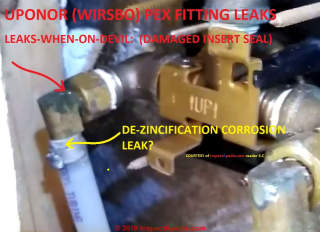 2019/11/08 InspectApedia.com reader S.C. reports by his own video having found leaks at PEX connectors used to connect Uponor TuffPEX tubing to a brass shower control.
2019/11/08 InspectApedia.com reader S.C. reports by his own video having found leaks at PEX connectors used to connect Uponor TuffPEX tubing to a brass shower control.
S.C. found corrosion that may be de-zincification discussed above, but significantly he found that the combination of over-tightening of the brass PEX-to-Fixture connector crushed, split, or otherwise damaged the Wirsbo / Uponor PEX connector seal inserts leading to leaks that could be difficult to track down - the fittings leaked only when the shower was on.
The red arrow points to blackened corrosion at the fitting's insert into the connector to the shower control. (The shower control is new, the original one having been replaced).
This leak was due to a damaged UPONOR (Wirsbo) PEX tubing seal that inserts into the fitting end that connects to the shower control.
A second leak is developing at the same fitting, shown by the white mineral salts around the fitting near the clamp securing the UPONOR TuffPEX to the fitting (yellow arrow).
Below the reader holds the original UPONOR TuffPEX fitting seal - a yellow ring intended to seal the fitting to the female threaded connection of, in this case, a shower control water inlet line.
The shredded PEX fitting yellow sealing ring is probably due to over-tightening at original installation but might also be caused by subsequent re-tightening of the connector in an effort to stop a leak that could be from the seal OR could be from mistaking a leak due to de-zincification in the brass fitting itself for a loose fitting.
The photo below illustrates a tapered red PEX fitting sealing ring sold as a replacement to repair leaky PEX fitting seals. This tapered red PEX fitting seal ring is provided by PlumbMaster.
Watch out: OPINION: if your PEX fittings are corroded and if you're not certain that the leak is due to the seal rather than to pinhole leaks in the brass fitting, it may bes to simply replace the fittings rather than risk ongoing leak damage and the cost of doing the same repair job twice.
- PlumbMaster, 2951 Highway 501 East, Conway S.C. 29526 USA. Website: https://www.plumbmaster.com/wolverinebrass/ Tel: 1-800-523-5130
Also see "Leaks-When-On Devils" discussed
at LEAK TYPES, WATER SUPPLY or DRAIN PIPES.
- SharkBite Plumbing Solutions, SharkBite USA
2300 Defoor Hills Rd. NW
Atlanta, GA 30318
USA Tel: 1-877-700-4242
SharkBite Canada 74 Alex Avenue Vaughan, Ontario, L4L 5X1 Canada, tel: 1-888-820-0120 retrieved 2020/01/19 original source: https://www.sharkbite.com/
SHARKBITE INSTALLATION GUIDE [PDF] (2018) Reliance Worldwide Corporation 2300 Defoor Hills Rd NW, Atlanta, GA 30318 Phone: 1-877-700-4242 Fax: 1-877-700-4280 rwc.com Reliance Worldwide Corporation (Canada) Inc. 74 Alex Avenue Vaughan, Ontario, L4L 5X1 Phone: 1-888-820-0120 Sales Inquiries: canadasales@rwc.com Orders: canadaorders@rwc.com retrieved 2019/08/13 original source: https://www.sharkbite.com/sites/g/files/rgohfh321/files/2018-05/SharkBite_Installation_Instructions_2018_WEB.
...
Reader Comments, Questions & Answers About The Article Above
Below you will find questions and answers previously posted on this page at its page bottom reader comment box.
Reader Q&A - also see RECOMMENDED ARTICLES & FAQs
Question: installing PEX in concrete
(July 17, 2014) Anonymous said:
When putting pex in concrete do you need to pressurize the system before you pour the concrete?
Reply:
While I can't cite an authoritative reference, certainly I've never seen a system pressurized before installation. I do see that the pex tubing is capped and supported above the slab to keep it accessible and clean at its connection points.
Question:
(Nov 8, 2014) Anonymous said:
After the Zurn, Uponor and other class action lawsuits related to dezincification problems with brass fittings, did they take measures to correct the problem and if so how can I be certain I am not purchasing a defective brass fitting?
Reply:
You may have missed it, but the article above reports ongoing leak concerns, most likely where water chemistry is an important factor.
...
Continue reading at PEX PIPING INFORMATION - topic home, or select a topic from the closely-related articles below, or see the complete ARTICLE INDEX.
Or see these
Recommended Articles
- LEAK TYPES, WATER SUPPLY or DRAIN PIPES
- PEX PIPING INFORMATION
- PLASTIC PIPING ABS CPVC PB PEX PPR PVC - home
- PLASTIC vs. COPPER PIPES in BUILDINGS - separate article
- PLASTIC PIPE LEAK CAUSES
- PlumbPex® PEX LEAKS & LAWSUIT - separate article
- Kitek® PLASTIC PIPELEAKS & LAWSUIT - separate article
Suggested citation for this web page
PEX BRASS CONNECTOR LEAKS at InspectApedia.com - online encyclopedia of building & environmental inspection, testing, diagnosis, repair, & problem prevention advice.
Or see this
INDEX to RELATED ARTICLES: ARTICLE INDEX to PLUMBING SYSTEMS
Or use the SEARCH BOX found below to Ask a Question or Search InspectApedia
Ask a Question or Search InspectApedia
Try the search box just below, or if you prefer, post a question or comment in the Comments box below and we will respond promptly.
Search the InspectApedia website
Note: appearance of your Comment below may be delayed: if your comment contains an image, photograph, web link, or text that looks to the software as if it might be a web link, your posting will appear after it has been approved by a moderator. Apologies for the delay.
Only one image can be added per comment but you can post as many comments, and therefore images, as you like.
You will not receive a notification when a response to your question has been posted.
Please bookmark this page to make it easy for you to check back for our response.
IF above you see "Comment Form is loading comments..." then COMMENT BOX - countable.ca / bawkbox.com IS NOT WORKING.
In any case you are welcome to send an email directly to us at InspectApedia.com at editor@inspectApedia.com
We'll reply to you directly. Please help us help you by noting, in your email, the URL of the InspectApedia page where you wanted to comment.
Citations & References
In addition to any citations in the article above, a full list is available on request.
- Atkinson, Clare A., Dianne F. Jolley, and Stuart L. Simpson. "Effect of overlying water pH, dissolved oxygen, salinity and sediment disturbances on metal release and sequestration from metal contaminated marine sediments." Chemosphere 69, no. 9 (2007): 1428-1437.
- Bean, Robert, "The History and Influence of PEX Pipe on Indoor Environmental Quality", healthyheating online article (2007), Email: info@healthyheating.com, website: www.healthyheating.com, retrieve 6/25/2014, original source: http://www.healthyheating.com/History_of_Pex.htm
- Bean, Robert, Bjarne W. Olesen, Ph.D., Kwang Woo Kim, Arch.D., "History of Radiant Heating & Cooling Systems", ASHRAE Journal, January 2010, Website: ASHRAE.org
- Desai, Rahul A., and Dean G. Assimos. "Accuracy of urinary dipstick testing for pH manipulation therapy." Journal of Endourology 22, no. 6 (2008): 1367-1370.
- Dickson, Andrew G. "The measurement of sea water pH." Marine chemistry 44, no. 2 (1993): 131-142.
- Ficklin, W. H., and E. L. Mosier. "Field methods for sampling and analysis of environmental samples for unstable and selected stable constituents." The environmental geochemistry of mineral deposits. Society of Economic Geologists. Part A (1999): 249-264.
- Gleick, Peter H. "The development and testing of a water balance model for climate impact assessment: modeling the Sacramento basin." Water Resources Research 23, no. 6 (1987): 1049-1061.
- Kahn, Gary, Steve Nowlan, and John McDermott. "MORE: an intelligent knowledge acquisition tool." In IJCAI, pp. 581-584. 1985.
- Levine, Robert L., Robert E. Fromm Jr, Mojtaba Mojtahedzadeh, Ali A. Baghaie, and Antone R. Opekun Jr. "Equivalence of litmus paper and intragastric pH probes for intragastric pH monitoring in the intensive care unit." Critical care medicine 22, no. 6 (1994): 945-948.
- Lesho, Emil P., and Bernard J. Roth. "Is pH paper an acceptable, low-cost alternative to the blood gas analyzer for determining pleural fluid pH?." CHEST Journal 112, no. 5 (1997): 1291-1292.
- Neill, K. M., K. T. Rice, and H. L. Ahern. "Comparison of two methods of measuring gastric pH." Heart & lung: the journal of critical care 22, no. 4 (1992): 349-355.
- Palmer, M. R., and Paul Nicholas Pearson. "A 23,000-year record of surface water pH and pCO2 in the Western Equatorial Pacific Ocean." Science 300, no. 5618 (2003): 480-482.
- Rossum, J. R. "Conductance method for checking accuracy of water analyses." Analytical Chemistry 21, no. 5 (1949): 631-631.
- Sorensen, S. P. L. "ErgÄnzung zu der Abhandlung: Enzymstudien II: über die Messung und die Bedeutung der Wasserstoffionenkonzentration bei enzymatischen Prozessen." Biochem. Z 22 (1909): 352-356.
Sorensen, SPL "Supplement to the paper: Enzyme Studies II: about the measurement and the significance of the hydrogen ion concentration in enzymatic processes." Biochem. Z 22 (1909): 352-356. - Thomas, G. W. "Soil pH and soil acidity." Methods of soil analysis. Part 3 (1996): 475-490.
- Walpole, George Stanley. "Chart presentation of recent work on indicators." Biochemical Journal 5, no. 5 (1911): 207.
- Ward, K. M., and R. S. Balaban. "Determination of pH using water protons and chemical exchange dependent saturation transfer (CEST)." Magnetic resonance in medicine 44, no. 5 (2000): 799-802.
- Eric Galow, Galow Homes, Lagrangeville, NY. Mr. Galow can be reached by email: ericgalow@gmail.com or by telephone: 914-474-6613. Mr. Galow specializes in residential construction including both new homes and repairs, renovations, and additions.
- Eric Galow, Galow Homes, Lagrangeville, NY. Mr. Galow can be reached by email: ericgalow@gmail.com or by telephone: 914-474-6613. Mr. Galow specializes in residential construction including both new homes and repairs, renovations, and additions.
- [7] PB Technology Center (information about PB Pipes) Tel: 800-338-7732, also see the 1990 PB Pipe recommendations published by the Polybutylene Product Line Committee of the Plastic Pipe and Fittings Association.
- Polybutylene Plumbing Failures: Spencer Class settlement, Web: spencerclass.com, 10% of replacement cost/damages, only for acetal (plastic)fittings
- [12] Zurn Manufacturing, Web: zurn.com , Zurn Pex, Inc., Highway 11 East, Commerce, TX 75428, Tel: (903) 886-2580
provides information about installing and using PEX piping including Type b PEX through their website. Quoting from the company's website
Zurn was founded in 1900 in Erie, PA. It originally manufactured a patented backwater valve, and it now manufactures and distributes one of the largest plumbing products packages in the world! Zurn includes: the Specification Drainage Operation, AquaFlush flush valves, AquaSense sensor-operated plumbing products, AquaSpec commercial faucets, Wilkins, Zurn Light Commercial, Flo-Thru, the Chemical Drainage Systems, Zurn PEX Plumbing Systems and Zurn Radiant Heat. - [13] Zurn PEX PLUMBING DESIGN AND APPLICATION GUIDE [PDF] - web search 2023/04/06 & 12/23/2010, original source zurn.com/operations/pexrh/pdfs/installation/PEXDesApplGuide.pdf
- [14] Zurn Pex Plumbing
Products Liability Litigation, United States Court of Appeals
FOR THE EIGHTH CIRCUIT, No. 10-2267, Filed 6 July 2011, Quoting:
Minnesota homeowners brought this action1 against Zurn Pex, Inc. and Zurn Industries, Inc (Zurn) alleging that brass fittings used in the company's cross linked polyethylene (PEX) plumbing systems are inherently defective. In pretrial motions the homeowners sought class certification for their consumer protection, warranty, and negligence claims, and Zurn moved to strike the testimony of two of the homeowners’ experts. After denying Zurn's motion to strike the expert testimony, the district court2 granted the homeowner requests for class certification for their warranty and negligence claims, but denied it for their consumer protection claims. Zurn appeals from the district court's certification order. We affirm.
Web search 4/12/12, original source: www.ca8.uscourts.gov/opndir/11/07/102267P.pdf - [15] Uponor, Inc., F1807 Plumbing Court File No. - United States District Court, District of Minnesota, In Re: Uponor, Inc., F1807 Plumbing Court File No. 11-MD-2247 ADM/JJK
Fittings Products Liability Litigation, "
Order Granting Motion to Certify Class for Settlement Purposes and for Preliminary Approval of Class Action Settlement and Form and Dissemination of Notice to the Class" Quoting:
The Motion for Preliminary Approval of Class Action Settlement was heard on January 12, 2012. After review of pleadings and briefing, and having heard the arguments of counsel for good cause shown, it is hereby ORDERED that: (1) the Motion for Preliminary Approval of Nationwide Class Action Settlement Agreement; (2) preliminary and conditional certification of a settlement class; (3) approval of the form and content of Notice and Settlement; (4) an injunction and stay of all claims and actions against the RTI Defendants
Web search 4/12/12, original source: http://www.mnd.uscourts.gov/MDL-Uponor/ - [16] Bonnie Ransom Stern & Gustavo Lagos, "Are There Health Risks from the Migration of Chemical Substances from Plastic Pipes into Drinking Water? A Review", Human and Ecological Risk Assessment: An International Journal
Volume 14, Issue 4, 2008, Abstract:
Plastic pipes used to convey hot and cold drinking water are synthetic polymers containing numerous additives that enhance durability, impact strength, and toughness, and resist material degradation. Although some research studies have been conducted to evaluate the type and levels of chemical substances migrating from polymeric materials into drinking water, the potential adverse health effects associated with these compounds in potable water have not been described. This review evaluates the literature on the occurrence of regulated and unregulated substances in drinking water related to the use of plastic pipes, characterizes potential health hazards, and describes uncertainties associated with human health and exposure in need of further research. Of particular public health concern is the potential for sensitive populations to be exposed to short-term elevations in leachates during critical periods, and for co-occurring leachates targeting the same organ(s) and/or sharing a common mode of toxic action to have additive or synergistic effects. Contaminants are measured in the distribution system, not at the tap where human exposure actually occurs. For increased health protection, it is important to identify compounds that migrate from plastic pipes into drinking water and to better quantify human exposures and health hazards to these substances and their degradates. - [17] Andrew J. Whelton, Andrea M. Dietrich, Daniel L. Gallagher, "Chapter 6 Impact of Chlorinated Water Exposure on Chemical Diffusivity and Solubility,
Surface and Bulk Properties of HDPE and PEX Potable Water Pipe", in Advancing Potable Water Infrastructure through an Improved Understanding of Polymer
Pipe Oxidation, Polymer–Contaminant Interactions, and Consumer Perception of Taste, Andrew James Whelton
Dissertation submitted to the Faculty of the
Virginia Polytechnic Institute and State University
In partial fulfillment of the requirements for the degree of
DOCTOR OF PHILOSOPHY
In
Civil Engineering
Andrea M. Dietrich, Chair
Daniel L. Gallagher
Marc A. Edwards
Brian J. Love
James M. Tanko, April 2, 2009
Blacksburg, Virginia. Abstract: While more than 100 years of research has focused on removing acute and chronic health
threats from water, substantially less study has focused on potable water infrastructure and water
quality deterioration, monitoring technologies, and relationships between water taste and
consumer health. These knowledge–gaps have left infrastructure users, owners, regulators, and
public health professionals largely unaware of how premise and buried polymer water pipes
deteriorate and sorb/ desorb organic contaminants during normal operations and following water
contamination events. These knowledge–gaps also prevent infrastructure managers from
producing drinking water that optimizes mineral content for both water taste and health benefits,
and employing a monitoring tool capable of immediately detecting water contamination or
equipment failures.
Research was conducted to address these challenges using analytical chemistry,
environmental engineering, food science, polymer chemistry, public health, and material science
principles. This work was enhanced by collaborations with sixteen American water utilities and
the National Institute for Standards and Technology. These efforts were funded by the National
Science Foundation, American Water Works Association, and the Water Research Foundation.
Research results are unique and provide important scientific contributions to the public
health, potable water, and material science industries. Particular achievements include the: (1)
Evaluation of linkages between minerals, water palatability, and health useful for water
production and public health decisions; (2) Creation of a novel infrastructure and water quality
surveillance tool that has begun water utility implementation in the USA; (3) Development of an
accelerated chlorinated water aging method with stable water pH, free chlorine, and alkalinity
concentration that enables interpretation of polymer pipe surface and bulk characteristic changes;
(4) Discovery that polar compounds are 2–193% more soluble in PEX than HDPE water pipes;
(5) Finding that several polymer and contaminant properties can be used to predict contaminant diffusivity and solubility during sorption and desorption in new, lab aged, and water utility PE
pipes; and the (6) Discovery that chlorinated water exposure of HDPE and PEX pipes increases
polar contaminant diffusivity during sorption by 50–162% and decreases diffusivity during
desorption as much as 211%. Outcomes of this work have domestic and global significance, and
if engaged, can greatly improve public health protection, potable water infrastructure operations,
water quality, sustainability, and regulation. - [18] Chemax, "Cross-Linked Polyethylene Tubing and Water Contamination", retrieved 2/17/2013, original source: http://www.chemaxx.com/polytube1.htm [copy on file as [Water Contamination chemical investigation.pdf]
- [19] Ingun Skjevrak, Anne Due, Karl Olav Gjerstad, Hallgeir Herikstad "Volatile organic components migrating from plastic pipes (HDPE, PEX and PVC) into drinking water", Water Research Volume 37, Issue 8, April 2003, Pages 1912–1920
Abstract: High-density polyethylene pipes (HDPE), crossbonded polyethylene pipes (PEX) and polyvinyl chloride (PVC) pipes for drinking water were tested with respect to migration of volatile organic components (VOC) to water. The odour of water in contact with plastic pipes was assessed according to the quantitative threshold odour number (TON) concept. A major migrating component from HDPE pipes was 2,4-di-tert-butyl-phenol (2,4-DTBP) which is a known degradation product from antioxidants such as Irgafos 168®. In addition, a range of esters, aldehydes, ketones, aromatic hydrocarbons and terpenoids were identified as migration products from HDPE pipes. Water in contact with HDPE pipes was assessed with respect to TON, and values ⩾4 were determined for five out of seven brands of HDPE pipes. The total amount of VOC released to water during three successive test periods were fairly constant for the HDPE pipes. Corresponding migration tests carried out for PEX pipes showed that VOC migrated in significant amounts into the test water, and TON ⩾5 of the test water were observed in all tests. Several of the migrated VOC were not identified. Oxygenates predominated the identified VOC in the test water from PEX pipes. Migration tests of PVC pipes revealed few volatile migrants in the test samples and no significant odour of the test water. - [20] Andrew J. Whelton, Ph.D., M.ASCE; Andrea M. Dietrich, Ph.D., Aff.ASCE; and Daniel L. Gallagher, Ph.D., P.E., M.ASCE, ”Contaminant Diffusion, Solubility, and Material Property Differences between HDPE and PEX Potable Water Pipes.” J. Environ. Eng., 136(2), 227–237.
doi: 10.1061/(ASCE)EE.1943-7870.0000147
Abstract: the objectives of this work were to identify differences between the composition, bulk properties, contaminant diffusivity and solubility for new high-density polyethylene (HDPE) pipe and crosslinked polyethylene (PEX) pipe, as well as determine which contaminant and polymer properties are useful for predicting contaminant fate in water pipe. Variations in PE pipe density (0.9371–0.9547 g/cm3) , crystallinity (69–72%), crosslinking (60 and 76%), and oxidative induction time (33 to >295 min .) were detected. While numerically these differences seem minor, results show that slight material differences have a notable effect on contaminant diffusivity and solubility. Nonpolar contaminant diffusivity and solubility were best predicted by bulk density. Polar contaminants were more soluble and diffused faster through PEX than HDPE pipes because PEX pipes contained a greater amount of oxygen. For all materials, dipole moment and Log Kow were good predictors of contaminant fate and molecular volume was only useful for predicting diffusivity and solubility values for haloalkane and nonpolar aromatic contaminants. - [21] Jia Tang, Daniel L. Gallagher, and Andrea M. Dietrich. (2013) Predicting Permeation of Organic Contaminants into Polyethylenes. Journal of Environmental Engineering 139:2, 205-212
Online publication date: 1-Feb-2013.
Abstract:
A model was developed and validated for predicting solubility and diffusion coefficients for contaminants permeating polyethylene (PE) materials used for water pipes and geomembranes. Model development was based on diffusivity and solubility of 13 contaminants and six PE materials that were new and/or aged in chlorinated water. Physical and chemical properties of the contaminants and PEs were included as variables in the model. Tree regression was used to select variables, and multiple linear regression was used to develop predictive equations for contaminant diffusivity and solubility in PE. Organic contaminant properties, especially dipole moment and octanol-water partition coefficient, had greater predictive capability than PE properties. Coefficients of determination (R2)>0.8 were obtained for the multiple linear regressions. Model coefficients changed slightly between new PE materials and chlorine-aged PE, but these changes were not statistically significant. Good agreement was demonstrated between model predictions and measured data from an independent data set. These results provide guidance for material selection for both water pipes and geomembranes and assessing contamination potential. - [22] Andrew J. Whelton, Andrea M. Dietrich, and Daniel L. Gallagher. (2011) Impact of Chlorinated Water Exposure on Contaminant Transport and Surface and Bulk Properties of High-Density Polyethylene and Cross-Linked Polyethylene Potable Water Pipes. Journal of Environmental Engineering 137:7, 559-568
Online publication date: 1-Jul-2011. Abstract:
The aim of this work was to determine if the aging of polyethylene (HDPE, PEX-A and PEX-B) water pipes by exposure to chlorinated water altered polar and nonpolar contaminant diffusivity and solubility by analyzing new, laboratory-aged, and exhumed water-distribution system polyethylene (PE) pipes. After 141 days of aging in pH 6.5 water with 45 mg/L free chlorine, the surface chemistry and bulk properties of PEX-A pipe were unaffected. Carbonyl bonds (σ=1,713 cm−1) were detected on the surfaces of HDPE and PEX-B pipe, and these oxygenated surfaces became more hydrophilic, resulting in statistically significant increases in diffusion rates. All 10 contaminant and four pipe material combinations had diffusivity increases on average of 50% for polar contaminants and 5% for nonpolar contaminants. Contaminant solubility was slightly increased for aged PEX-A and slightly decreased for PEX-B pipes. Toluene and trichloromethane diffusivity and solubility values for 7- to 25-year-old buried water utility pipes were similar to values for new and laboratory-aged HDPE-based materials. Because chlorinated water exposure alters how polar contaminants interact with aged PE pipes, results of this work should be considered in future health risk assessments, water quality modeling, pipe performance, and service-life considerations. - [23] ANDREW J. WHELTON & TINH NGUYEN, "Contaminant Migration from Polymeric Pipes used in Buried Potable Water Distribution Systems: A Review", Critical Reviews in Environmental Science and Technology, February 2012 posted online,
Abstract: Polymeric pipes are increasingly being installed in water distribution systems because of their many advantages. Contaminant migration from polymer pipes into drinking water is a growing concern in the United States and environmental engineers are evaluating the role of these materials on water quality, system operation, and regulatory compliance. To aid these efforts and serve as a source of background information, this paper critically reviews available literature on polymeric potable water pipes in use, known contaminants released from in–service and new piping, their perceived sources, and outlines future challenges in the U.S. and abroad. - [24] Andrew James Whelton, "Advancing Potable Water Infrastructure through an Improved Understanding of Polymer Pipe Oxidation, Polymer–Contaminant Interactions, and Consumer Perception of Taste", Dissertation submitted to the Faculty of the Virginia Polytechnic Institute and State University In partial fulfillment of the requirements for the degree of DOCTOR OF PHILOSOPHY In Civil Engineering, April 2, 2009 Blacksburg, Virginia, retrieved 2/17/2013, original source http://scholar.lib.vt.edu/theses/ available/etd-04162009-113815/unrestricted/ FINALWheltonDissertationMay09.pdf#page=158
- [25] Website: GreenBuildingAdvisor.com, "PEX vs Copper", retrieved 2/18/2013, original source: http://www.greenbuildingadvisor.com/ community/forum/green-products-and-materials/ 16256/pex-vs-copper [copy on file as PEX vs Copper _ GreenBuildingAdvisor.pdf]
- [26] Website: GreenBuildingAdvisor.com," How Safe is PEX tubing?", retrieved 2/18/2013, original source: http://www.greenbuildingadvisor.com/ blogs/dept/qa-spotlight /how-safe-pex-tubing [copy on file as How Safe is PEX tubing_GreenBuildingAdvisor.pdf]
- [27] Lauren Hunter, "California’s PEX Battle Continues", Remodeling Magazine, June 2010, Website: Builderonline.com, "x", retrieved 2/18/2013, original souirce: http://www.builderonline.com/legislation/californias-pex-battle-continues.aspx [copy on file as California’s PEX Battle Continues - Plumbing, Legal Issues, Legislation - Builder Magazine.pd]
- [28] Contractor Magazine, "California approves PEX for plumbing — again- Contractor Magazine.pdf", retrieved 2/18/2013, original source: http://contractormag.com/news/ california-pex-plumbing-1234 [copy on file as California approves PEX for plumbing — again- Contractor Magazine.pdf]
- [29] "Sources of Lead [in and around the home]", New York State Health Department, website retrieved 2/19/2013, original source: http://www.health.ny.gov/environmental/lead/sources.htm [copy on file as Lead_Sources_NYS_DOH.pdf]
- [30] Wikipedia Web: https://www.wikipedia.org/ provided background information about some topics discussed at this website provided this citation is also found in the same article along with a " retrieved on" date. NOTE: because Wikipedia entries are fluid and can be amended in real time, we cite the retrieval date of Wikipedia citations and we do not assert that the information found there is necessarily authoritative. Kitec web search retrieved 02/19/2013, original source: http://en.wikipedia.org/wiki/Kitec
- In addition to citations & references found in this article, see the research citations given at the end of the related articles found at our suggested
CONTINUE READING or RECOMMENDED ARTICLES.
- Carson, Dunlop & Associates Ltd., 120 Carlton Street Suite 407, Toronto ON M5A 4K2. Tel: (416) 964-9415 1-800-268-7070 Email: info@carsondunlop.com. Alan Carson is a past president of ASHI, the American Society of Home Inspectors.
Thanks to Alan Carson and Bob Dunlop, for permission for InspectAPedia to use text excerpts from The HOME REFERENCE BOOK - the Encyclopedia of Homes and to use illustrations from The ILLUSTRATED HOME .
Carson Dunlop Associates provides extensive home inspection education and report writing material. In gratitude we provide links to tsome Carson Dunlop Associates products and services.


